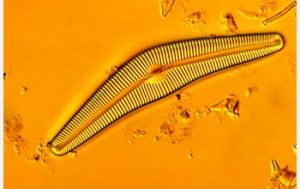Diatoms
Diatoms are single celled planktonic algae with external skeleton made of silica. Viewed under microscopes, diatoms show a huge variety of shapes with many interesting and beautiful patterns. They can appear as filaments, chains, or colonies, either in the water column (phytoplankton) or attached to any single substratum (benthos), and they are the among the most numerous algae, particularly the Southern Ocean around Antarctica, and also in sea ice. Diatoms are thus a major food resource for marine and freshwater microorganisms and animal larvae.
Diatoms are divided into two Orders:
- The Centrales (now called the Biddulphiales) which have valve striae arranged basically in relation to a point, an annulus or a central areola and tend to appear radially symmetrical,
- and the Pennales (now called Bacillariales) which have valve striae arranged in relation to a line and tend to appear bilaterally symmetrical.
They appeared millions of years ago, along with dinosaurs. They’re involved in the biogeochemical cycling of silica and are virtually inherent in every environment ranging from water to ice to soil. The silica shells are left behind when a diatom dies, forming diatomaceous earth.
Diatoms are “champions of photosynthesis” produce 25-40% of the oxygene we breathe.
Photo: Diatom species Cymbella cistulaMark B. Edlund, Ph.D.



 This project (EDU-ARCTIC) has received funding from the European Union’s Horizon 2020 research and innovation programme under grant agreement No 710240. The content of the website is the sole responsibility of the Consortium and it does not represent the opinion of the European Commission, and the Commission is not responsible for any use that might be made of information contained.
This project (EDU-ARCTIC) has received funding from the European Union’s Horizon 2020 research and innovation programme under grant agreement No 710240. The content of the website is the sole responsibility of the Consortium and it does not represent the opinion of the European Commission, and the Commission is not responsible for any use that might be made of information contained.